“Come forth into the light of things, let nature be your teacher,” wrote William Wordsworth in his poem from 1798 titled The Tables Turned. Any conspiracy theorist worth his salt would have loved to jump on that line as a prediction of what is to come.
Today we see the Internet of Things weaving its magic to revolutionise lighting. The latest bulbs let you adjust the intensity and colour to mimic natural light. These can transform from a bright white-yellow like the morning Sun to a warmer and more golden-red part of the spectrum in the afternoon. Or these can allow you to simulate an entire golden forest, which is what Japanese electronics component manufacturer ROHM did just last year. What is enabling all this?

What happened to hardware
“A lot of changes have occurred since last year, such as the change from emitter technology to chip on board technology, different soldering processes for different chip manufacturers, driver requirements for various wattages and much more. This is a continuous process and a manufacturer needs to adapt according to this dynamic change,” say Siva Satheesh, managing director, and Abdul Basith, executive director, Euro Lights, India.
Belkin WeMo devices run on Qualcomm’s Atheros AR9331 system on chip (SoC). Disney Research published a white paper where they discuss an innovative LED-to-LED communication system that uses the same SoC along with an 8-bit ATmega328p running Visible Light Communication (VLC) firmware and connected to an amplification board. It uses visible light to send data at a rate of up to 1kbps. The do-it-yourself bulbs are designed to interact with other gadgets that may not have full Wi-Fi connectivity and instead read data using VLC that uses visible light between 400THz and 800THz.
NXP’s GreenChip iSSL and GreenChip iCFL bring together wireless connectivity, energy-efficient lighting and low-power standby in a solution that supports software stacks like Zigbee and JenNet. JenNet-IP is a 6LoWPAN mesh-under-tree network with low memory footprint, specifically targeting low-power IEEE 802.15.4 based networking for residential and industrial applications. ZigBee LightLink is a standards based solution targeting in-room lighting for residential applications.
LEDSENSE is a new low-voltage driver architecture created by a company named Terralux. The company claims that they program LM-80 curve (an industry standard that lets users evaluate LEDs) into each product and monitor the temperature to ensure the LED is not overdriven for ambient temperature, and also ensure that their products comply with NEMA SSL6/7 dimming standards.
Back in India, OMTRONICS Twilight Switch is a sunlight based automatic on/off sensor that switches on at dusk and switches off at dawn.“Improved dimming is possible by Android devices, infrared sensors and Bluetooth controllers these days. You also see motion sensors based light on/off control,” says I. Hari Prasad from Omtronics.

FLYON is a lighting device being developed by Quantum Dots, which glows while floating in air without any wired connection. “It works on the amalgamation of maglev and Witiricity. FLYON involves lifting forces, electromagnetic suspension, position sensing, magnetic flux, flux orientation and frequency of operation including Witiricity. Witricity power sources and capture devices are specially designed magnetic resonators that efficiently transfer power over short distances via the magnetic near-field,” explains T.A. Babu, managing director, Quantum Dots Technology Pvt Ltd, Quantum Dots.
Plessey announced its range of MaGIC LED die manufactured on the company’s patented GaN-on-Silicon technology. The blue die is referred to in the company’s press release as a blue pump for its ability to pump phosphor to a white colour range.
Overall, there seems to be a focus on improving the communications aspect of lighting as well as enabling greater precision with which these can be controlled.
What happened to the controls
A virtual home for every light bulb—that is what the future of smart lighting promises us (and delivering, too!). By having an Internet address for every bulb to call home, we gain the ability to call it up and control it as we please from anywhere across the globe through the Internet.

One innovative way to control lights is when wearable devices get in on the control game, too. Misfit is coming up with Misfit Home Service that will let Misfit fitness trackers tell the lights when to brighten up. One use case is where the tracker detects the level of sleep of the user and uses lights to simulate a sunrise inside the bedroom.
Sensor based lighting systems are now being made smarter to fit in with human behaviour and responses. For instance, motion sensor systems that switch lights based on people entering the room can now differentiate between a pet and a person. These also do not switch off immediately when a person leaves, instead keep the light on for a few minutes as people tend to feel creepy when lights behind them shut off as they walk through a hall.
Lutron and Insteon have had their lighting kits designed to work flawlessly with Apple’s HomeKit devices. This means users can control lighting by speaking to their phone or watch.
Cisco Smart+Connected City Lighting solution combines with their City Multi Sensor Node to create a light-sensory network. These standards based systems gather a wide variety of data from the environment, including levels of humidity, CO2 and O2, UVA and UVB light, particulate matter, motion and seismic activity, video, sound and more.
There is one thing to be wary of, however. “The problem with some app based systems is that, whenever you are activating lights through a mobile phone, you are going through servers from different countries. So full dependency is on the server located in that country. This leads to a situation where external firms retain control over home automation systems. Even big firms have systems supported by servers in certain risky countries,” explains Joy Biswas, product manager, Forbix Semicon.
How is Forbix solving the problem? They had designed a system in 2007 that was supposed to be independent of these servers. They are now working on a better system that works on webmail servers, where triggers are sent through webmail, thus allowing for redundancy in the case of disrupted communication.

Plugging in some smarts
Not in the mood to build your own smart lighting system? There are some amazing products available that can let you plug in a smart lighting system into your home without having to get your hands dirty with code.
Philips Hue has stepped things up a notch. You can now use your iOS phone to not just switch on and off bulbs, but also pick colour, brightness and program timing, too. It also lets you use If This Then That service to get your lighting system to respond to situations like flashing red for a call from, say, your in-laws.
Elgato’s Avea is another Bluetooth Smart bulb rated at 7W and 430lm. Belkin has a similar functioning solution in its WeMo branded LED bulbs. LIFX is a similar product but works on Wi-Fi instead of Bluetooth Low Energy. Belkin has also brought out a WeMo light switch that lets you control dumb bulbs with your phone.
If you really want to take things ahead with your existing lighting and home electronics, then LightwaveRF has a solution to swap your home’s sockets with their Internet-enabled switches. GE Link is another option that lets you remotely control and sync to a connected device through an app called Wink.
Those on a budget can look at Cree Connected LEDs, as these are one of the most inexpensive bets available. For a more all-inclusive integration, Lutron has a product named HomeWorks QS that can control not just light but interior and exterior systems, audio-visual and heating, ventilation and air-conditioning, making it more of a home environment control system. In line with this concept, it also lets you create scenes, which are preset light and shade levels. For example, press Entertain button on the keypad in your living room, and lights and shades will adjust throughout your home to create the pre-planned ambience.
What will happen to the switch
The US Navy’s design principle, “Keep it simple, stupid,” is now repeated by many designers. What can be simpler than a light switch? No switch!
Smart lighting is built on the premise that not only can you control your lights from anywhere, you can also set these up such that these do the controlling on their own. That means no more fumbling for the light switch when you get back home at night, or when you make your way to the kitchen in the middle of the night.
“There is a possibility that a new product that is highly innovative might not necessarily be cost-effective, user-friendly or eco-friendly. But when a new product or component meets these three criteria and satisfies customer requirements successfully with high satisfaction, then change is inevitable,” explains G. Jeganathan, director, GTP Equipments India Pvt Ltd.








